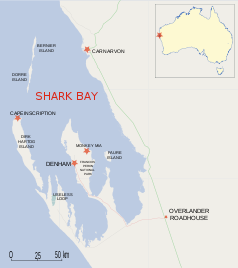Dirk Hartog Island National Park
| Dirk Hartog Island National Park | ||
|---|---|---|
| The Shark Bay with the Hartog Iceland (left) | ||
|
|
||
| Location: | Western Australia , Australia | |
| Next city: | Denham | |
| Surface: | 629.28 km² | |
| Founding: | 2009 | |
The Dirk Hartog Island National Park (English: Dirk Hartog National Park ) is a national park on Dirk Hartog Island in Western Australia . The island marks the end of the Shark Bay in the west to the Indian Ocean back and is part of the Shark Bay World Heritage Area , a UNESCO - World Heritage .
The national park is 850 kilometers north of Perth and can be accessed via Denham on the Péron Peninsula . It was founded in November 2009.
Surname
The national park and the island are named after Dirk Hartog , a Dutch navigator who landed on October 25, 1616 at the northern end of the island. He was the second European to set foot on Australia on what is now the island's Cap Inscription . There he attached a plaque to a wooden post.
geography
The island is made of limestone that is partially covered by dunes. The island is partly overgrown by bushes.
On Cap Inscripton to the north is the Cap Inscription Lighthouse and a lighthouse keeper's house. These buildings were built from 1908 to 1910. The lighthouse was automated in 1917 and in 2012 the keeper's house was refurbished on behalf of the Shire of Shark Bay .
To the east, the island is connected to Shark Bay Marine National Park , a marine reserve.
In the west of the island, limestone cliffs rise to a height of 150 meters.
In the south of Quoin Bluff there are remains of an army post with recognizable remains of a stone landing stage from 1851.
East of Dirk Hartog Island is the long Péron Peninsula with the François-Péron National Park in the northern part and Denham .
Flora and fauna
Large fields of seagrass stretch around the island , a source of food for dolphins and dugongs . There are also sharks .
The island's beaches are an important egg-laying area for the loggerhead turtle and the green sea turtle . In addition to whales and sea snakes observed.
81 species of birds and 61 species of migratory birds have been counted on the island. The island forms with Freycinet Island part of an Important Bird Area , a bird sanctuary. An endemic subspecies of the white-winged easel tail nests on the island . Quoin Bluff , located on the east coast of the island, is an important breeding colony for the Elsterscharbe .
Skinks, amphibians and crabs also live on the island.
tourism
The island is uninhabited. Because of the rich fishing grounds, the island is mainly sought out by anglers, but also because of the white sandy beaches. The island can be reached by ferry from the mainland.
Dirk Hartog Island can be entered and driven on with all-wheel drive vehicles. There are nine campsites. A fee must be paid before entering the island. Wood fires are not allowed, and rubbish is not allowed to be disposed of or buried on the island. Feces must be buried 50 centimeters deep 100 meters from the campsites.
Web links
- Description on the website of Parks and Wildlife Service (English)
- Information page of the island
- History of the island
Individual evidence
- ^ Department of Parks and Wildlife 2013-14 Annual Report (PDF), on parliament.wa.gov.au. Retrieved August 16, 2017
- ↑ Dirk Hartog Island National Park Information Guide. (PDF, 3.56 MB) In: Parks and Wildlife Service. Department of Parks and Wildlife, February 2015, accessed August 19, 2017 .
- ↑ a b Cape Inscription , on parks.dpaw.wa.gov.au. Retrieved August 16, 2017
- ↑ Quin Bluff South , on parks.dpaw.wa.gov.au. Retrieved August 16, 2017
- ↑ Nature Calendar , on dirkhartogisland.com. Retrieved August 16, 2017
- ↑ 4WD Barge Transfers , on dirkhartogisland.com. Retrieved August 16, 2017
- ↑ National Park Camping , on dirkhartogisland.com. Retrieved August 16, 2017
- ↑ Dampiers Landing / Sammys Well , on parks.dpaw.wa.gov.au. Retrieved August 16, 2017


